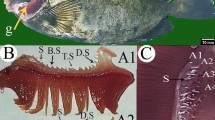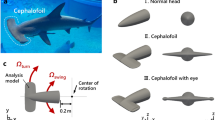Summary
We have identified 13 pairs of neurons in the pedal ganglia of the marine nudibranch slug Tritonia diomedea that responded tonically and/or phasically to water-flow directed at the rhinophore sheaths and oral veil tips. Most of the neurons responded equally to inputs from either side of the body, but 6 pairs responded with greater intensity to ipsilateral water-flow stimuli. When stimulated intracellularly in a semi-intact, whole-animal preparation, 4 of these 6 pairs of neurons caused ipsilateral movements that may turn the animal towards that side. These observations suggest a role for these current-sensitive neurons in the previously described orientation to water-currents in Tritonia diomedea.
Similar content being viewed by others
References
Audesirk G (1978a) Central neuronal control of cilia in Tritonia diomedea. Nature 272:541–543
Audesirk G (1978b) Properties of central motor neurons exciting locomotory cilia in Tritonia diomedea. J Comp Physiol 128:259–267
Audesirk G, Audesirk T (1980) Complex mechanoreceptors in Tritonia diomedea. I. Responses to mechanical and chemical stimuli. J Comp Physiol 141:101–109
Audesirk TE, Audesirk GJ (1979) Oral mechanoreceptors in Tritonia diomedea II. Role in feeding. J Comp Physiol 130:79–86
Birkeland CE (1974) Interactions between a sea pen and seven of its predators. Ecol Monogr 44:211–232
Chase R (1974) The electrophysiology of photoreceptors in the nudibranch mollusc, Tritonia diomedea. J Exp Biol 60:707–719
Chia F-S, Koss R (1982) Fine structure of the larval rhinophores of the nudibranch, Rostanga pulchra, with emphasis on the sensory receptor cells. Cell Tissue Res 225:235–248
Cook EF (1962) A study of food choices of two opisthobranchs, Rostanga pulchra McFarland and Archidoris montereyensis (Cooper). Veliger 4:194–196
Creutzberg F (1975) Orientation in space:animals. In: Kinne O (ed) Marine ecology- a comprehensive, integrated treatise on life in oceans and coastal waters, Vol II Physiological Mechanisms. John Wiley & Sons, London, pp 555–655
Crisp M (1969) Studies on the behavior of Nassarius obsoletus (Say) (Mollusca; Gastropoda). Biol Bull 136:355–373
Dickinson P (1979) Homologous neurons control movements of diverse gill types in nudibranch molluscs. J Comp Physiol 131:277–283
Dickinson P (1980) Gill control in the notaspidean Pleurobranchaea and possible homologies with nudibranchs. J Comp Physiol 139:11–16
Dorsett DA (1974) Neural homologies and the control of branchial tuft movements in two species of Tritonia. J Exp Biol 61:639–654
Dorsett DA (1978) Neurons controlling foot and mantle movements in Armina californica. Mar Behav Physiol 5:307–324
Dorsett DA (1986) Brains to cells: The neuroanatomy of selected gastropod species. In: Willows AOD (ed) The Mollusca, Vol 9 — Neurobiology and behavior, Part 2. Academic Press, Orlando, pp 101–187
Duch TM (1971) A rheotaxis study of three gastropod species. Veliger 14:73–76
Federighi H (1929) Rheotropism in Urosalpinx cinerea Say. Biol Bull 56:331–340
Field LH, MacMillan DL (1973) An electrophysiological and behavioral study of sensory responses in T. diomedea (Gastropoda, Nudibranchia). Mar Behav Physiol 2:171–185
Fredman SM, Jahan-Parwar B (1980) Role of pedal ganglia motor neurons in pedal wave generation in Aplysia. Brain Res Bull 5:179–193
Getting PA, Dekin MS (1985) Mechanisms of pattern generation in T. diomedea. IV. Gating of a central pattern generator. J Neurophysiol 53:466–480
Hening WA, Walters ET, Carew TJ, Kandel ER (1979) Motor neuronal control of locomotion in Aplysia. Brain Res 197:231–253
Hoyle G, Willows AOD (1973) Neuronal basis of behavior in Tritonia. II. Relationship of muscular contraction to nerve impulse pattern. J Neurobiol 4:239–254
Hume RI, Getting PA, del Beccaro MA (1982) Motor organization of Tritonia swimming. I. Quantitative analysis of swim behavior and flexion neuron firing patterns. J Neurophysiol 47:60–74
Hyde DC, Breuner CW (unpublished) Preferential orientation in the limpet, Lottia pelta. Zool 430/Botany 445 1990, Friday Harbor Laboratories, University of Washington
Lohmann KJ, Willows, AOD (1987) Lunar-modulated geomagnetic orientation by a marine mollusk. Science 235:331–334
Lohmann KJ, Willows AOD, Pinter RB (1991) An identifiable molluscan neuron responds to changes in earth-strength magnetic fields. J Exp Biol 161:1–24
Müller HG (1936) Untersuchungen über spezifische Organe niederer Sinne bei rhabdocoelen Turbellarien. Z Vergl Physiol 23:253–292
Neale JR (1965) Rheotactic responses in the marine mollusk Littorina planaxis Philippi. Veliger 8:7–10
Radke MG, Ritchie LS (1961) Field observations of the migration of marked Australorbis glabratus snails. J Parasitol 47:712
Rao G, Barnes CA, McNaughton BL (1986) Intracellular fluorescent staining with carboxyfluorescein: a rapid and reliable method for quantifying dye-coupling in mammalian central nervous system. J Neurosci Methods 16:251–263
Stinnakre J, Tauc L (1969) Central neuronal response to the activation or osmoreceptors in the osphradium of Aplysia. J Exp Biol 51:347–361
Von Gelei J (1930) “Echte” freie Nervenendigungen (Bemerkungen zu den Receptoren der Turbellarien). Z Morphol Ökol Tiere 18:786–798
Willows AOD (1978) Physiology of feeding in Tritonia diomedea. I. Behavior and mechanics. Mar Behav Physiol 5:115–135
Willows AOD, Dorsett DA, Hoyle G (1973a) The neuronal basis of behavior in T. diomedea. I. Functional organization of the nervous system. J Neurobiol 4:207–237
Willows AOD, Dorsett DA, Hoyle G (1973b) The neuronal basis of behavior in T. diomedea. III. Neuronal mechanism of a fixed action pattern. J Neurobiol 4:255–285
Author information
Authors and Affiliations
Rights and permissions
About this article
Cite this article
Murray, J.A., Hewes, R.S. & Willows, A.O.D. Water-flow sensitive pedal neurons in Tritonia: role in rheotaxis. J Comp Physiol A 171, 373–385 (1992). https://doi.org/10.1007/BF00223967
Accepted:
Issue Date:
DOI: https://doi.org/10.1007/BF00223967




